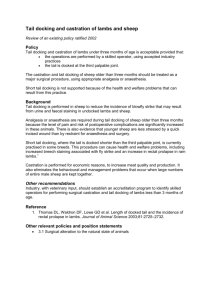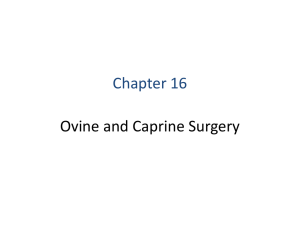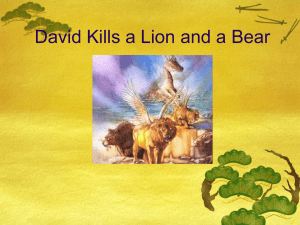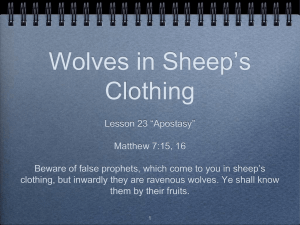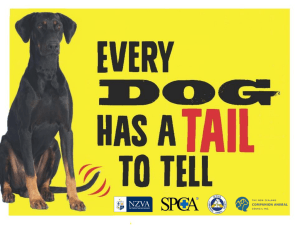Tail Docking of Sheep - UC Davis School of Veterinary Medicine
advertisement
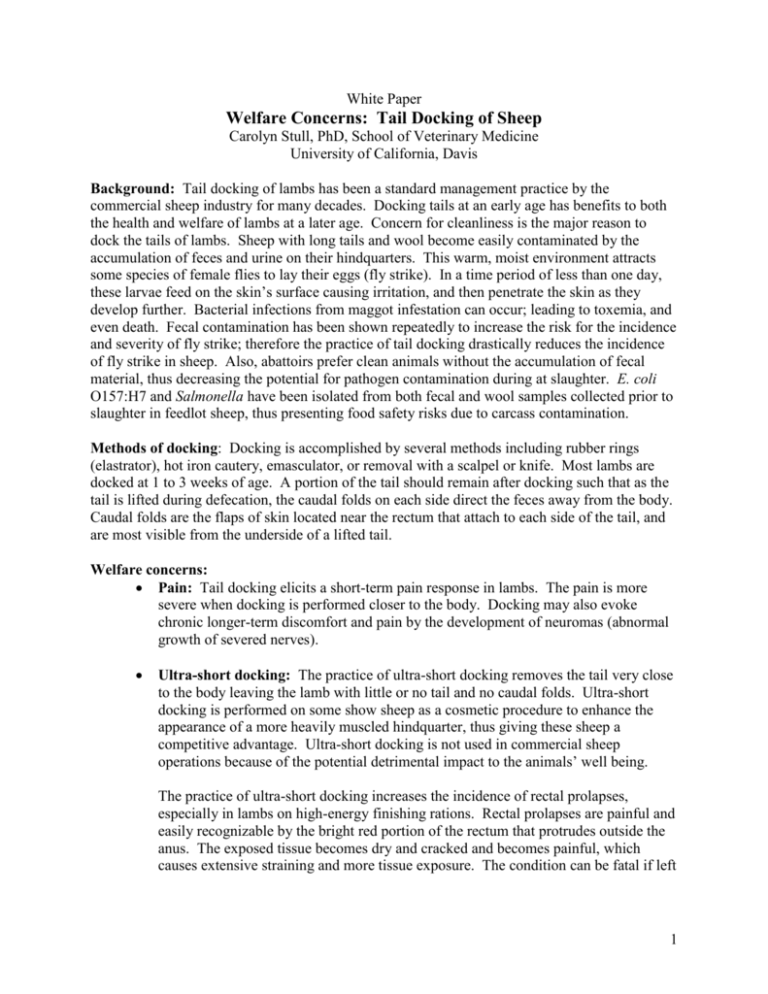
White Paper Welfare Concerns: Tail Docking of Sheep Carolyn Stull, PhD, School of Veterinary Medicine University of California, Davis Background: Tail docking of lambs has been a standard management practice by the commercial sheep industry for many decades. Docking tails at an early age has benefits to both the health and welfare of lambs at a later age. Concern for cleanliness is the major reason to dock the tails of lambs. Sheep with long tails and wool become easily contaminated by the accumulation of feces and urine on their hindquarters. This warm, moist environment attracts some species of female flies to lay their eggs (fly strike). In a time period of less than one day, these larvae feed on the skin’s surface causing irritation, and then penetrate the skin as they develop further. Bacterial infections from maggot infestation can occur; leading to toxemia, and even death. Fecal contamination has been shown repeatedly to increase the risk for the incidence and severity of fly strike; therefore the practice of tail docking drastically reduces the incidence of fly strike in sheep. Also, abattoirs prefer clean animals without the accumulation of fecal material, thus decreasing the potential for pathogen contamination during at slaughter. E. coli O157:H7 and Salmonella have been isolated from both fecal and wool samples collected prior to slaughter in feedlot sheep, thus presenting food safety risks due to carcass contamination. Methods of docking: Docking is accomplished by several methods including rubber rings (elastrator), hot iron cautery, emasculator, or removal with a scalpel or knife. Most lambs are docked at 1 to 3 weeks of age. A portion of the tail should remain after docking such that as the tail is lifted during defecation, the caudal folds on each side direct the feces away from the body. Caudal folds are the flaps of skin located near the rectum that attach to each side of the tail, and are most visible from the underside of a lifted tail. Welfare concerns: Pain: Tail docking elicits a short-term pain response in lambs. The pain is more severe when docking is performed closer to the body. Docking may also evoke chronic longer-term discomfort and pain by the development of neuromas (abnormal growth of severed nerves). Ultra-short docking: The practice of ultra-short docking removes the tail very close to the body leaving the lamb with little or no tail and no caudal folds. Ultra-short docking is performed on some show sheep as a cosmetic procedure to enhance the appearance of a more heavily muscled hindquarter, thus giving these sheep a competitive advantage. Ultra-short docking is not used in commercial sheep operations because of the potential detrimental impact to the animals’ well being. The practice of ultra-short docking increases the incidence of rectal prolapses, especially in lambs on high-energy finishing rations. Rectal prolapses are painful and easily recognizable by the bright red portion of the rectum that protrudes outside the anus. The exposed tissue becomes dry and cracked and becomes painful, which causes extensive straining and more tissue exposure. The condition can be fatal if left 1 untreated. The practice of ultra-short docking compromises the welfare of sheep without any long-term benefits for the animal. Recommendations: The following are general policies for docking tails of lambs. Dock only if necessary. Some breeds of sheep (Finn sheep and some hair sheep breeds) have shorter tails and/or less wool/hair on the tail. These breeds may not benefit from routine tail docking. Dock only healthy lambs less than 3 weeks of age. Dock the tail no shorter than the distal end (farthest from the body) of the caudal fold to maintain the function of the caudal folds. Policies: Several agricultural, governmental, and veterinary organizations have developed policy statements concerning the practice of ultra-short docking. These policies are based on research and practical or professional experiences. Animal welfare and practice codes in other countries (Canada, England, Australia, and New Zealand) recommend that the tail be long enough to cover the ewe’s vulva and be a similar length or cover the anus in male sheep. The recommendation of the American Veterinary Medical Association, which was endorsed by the American Association of Small Ruminant Practitioners and the American Sheep Industry Association, is that the tails of sheep be docked no shorter than or at the level of the distal end of caudal tail fold. The resolution of the Colorado Wool Growers recommends that all show sheep be docked at the third palpable joint from the body, and that this regulation be adopted by January 1, 1999 with full enforcement and compliance to take effect no later than January 1, 2000. In a joint position statement, the presidents of the California Veterinary Medical Association and the California Farm Bureau Federation signed a position statement (1999) for sheep shown at California fairs. This statement reads as follows: “All sheep—market and breeding animals—shown at California fairs receiving state funds should be docked according to the commercially-accepted practice, which exists for the sole purpose of protecting animal health and well-being. The tail should be healed at time of show. Docking for cosmetic purposes should be disallowed. Any animal that has been redocked, except for a medically justified reason, should be ineligible for show.” The North Carolina 4-H policy, which is similar to the West Virginia 4-H Program’s policy, states “Animals born after January 1, 2002, will be accepted for exhibition only if tails are not docked shorter than the level of the distal end of the caudal tail fold.” Proposed Policy for California 4-H policy: “The tail(s) of 4-H sheep exhibited in California should be docked no shorter than the distal end of the caudal tail fold. 2 Bibliography American Veterinary Medicine Association. 2000. Docking of Lambs’ Tails. (http://www.avma.org/issues/policy/animal_welfare/sheep.asp). Accessed July 15, 2009. Animal Welfare Advisory Committee. 1996. Code of Recommendations and Minimum Standards for the Welfare of Sheep. Section 5.8. Wellington, New Zealand. Canadian Code of Practice. 1995. Recommended Code of Practice for the Care and Handling of Sheep. Surgical Procedures, Section 11.3 Tail docking. Page 12. http://www.nfacc.ca/pdf/english/Sheep1995.pdf. Accessed July 15, 2009. Commonwealth of Australia. 2006. The Model Code of Practice for the Welfare of Animals: The Sheep. Page 11. Second Edition. http://www.publish.csiro.au/pid/5389.htm. Accessed July 15, 2009. Edrington, T.S., M. Long, T.T. Ross, J. D. Thomas, T. R. Callaway, R.C. Anderson, F. Craddock, M.W. Salisbury, and D. J. Nisbet. 2009. Prevalence and antimicrobial resistance profiles of Escherichia coli O157:H7 and Salmonella isolated from feedlot lambs. Journal of Food Protection. 72(8):1713-1717. Farm Animal Welfare Council. 2008. Report on the Implications of Castration and Tail Docking for the Welfare of Lambs. 31 pages. http://www.fawc.org.uk/pdf/report-080630.pdf. Accessed July 15, 2009. Fisher, M.W., N.G. Gregory, J.E. Kent, D.R. Scobie, D.J. Mellor and J.C Pollard. 2004. Justifying the appropriate length for docking lambs’ tails-a review of the literature. Proceedings of the New Zealand Society of Animal Production 64: 293-296. Ministry of Agriculture Fisheries and Food, 1999. Codes of Recommendations for the Welfare of Sheep, Section 63, Tail docking. Paragraph 13. United Kingdom. http://www.awtraining.com/pdf/pdffiles/sheep.pdf. Accessed July 15, 2009. Mellor, D.J. and L. Murray 1999. Effects of tail docking on behavior and plasma cortisol concentrations in young lambs. Research in Veterinary Science 46:387-391. Mellor, D.J. and K.J. Stafford. 2000. Acute castration and/or tailing distress and its alleviation in lambs. New Zealand Veterinary Journal 48:33-43. Scobie, D.R., A.R. Bray and D. O”Connell. 1999, A breeding goal to improve the welfare of sheep. Animal Welfare 8:391-406. Thomas D.L., D.F. Waldron, G.D. Lowe, D.G. Morrical, H.H. Meyer, R.A. High, Y.M. Berger, D.D. Clevenger, G.E. Fogle, R.G. Gottfredson, S.C. Loerch, K.E. McClure, T.D. Willingham, D.L. Zartman, and R.D. Zelinsky. 2003. Length of docked tail and the incidence of rectal prolapse in lambs. Journal Animal Science 81:2725–2732. United States Animal Health Association. 1999. Resolution 25. Committee on Sheep and Goats, Sheep Tail Docking. 103rd Annual Meeting of the USAHA, San Diego, October 7-14. Watts, J.E. and L.R. Luff. 1978. The importance of radical mules operation and tail length for the control of breech strike in scouring Merino sheep. Australian Veterinary Journal 54:356-357. Windels, H. 1990. Factors causing rectal prolapse in feedlot lambs. Pages 10-13. Proceedings of the 62nd Annual sheep and Lamb Feeders Day, University of Minnesota, Morris. Wood GN and V. Molony 1992. Welfare Aspects of Castration and Tail Docking of Lambs. In Practice 14:2-7. 3
